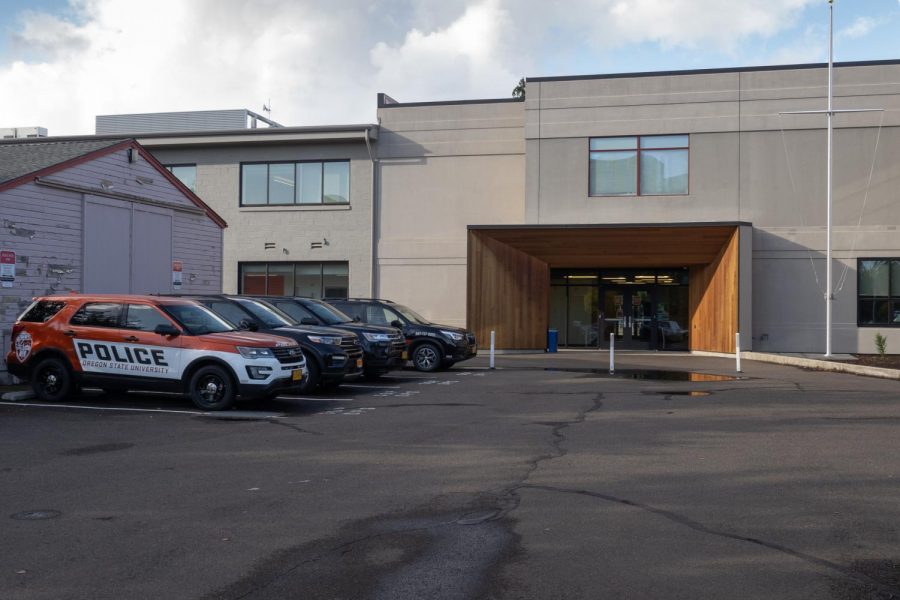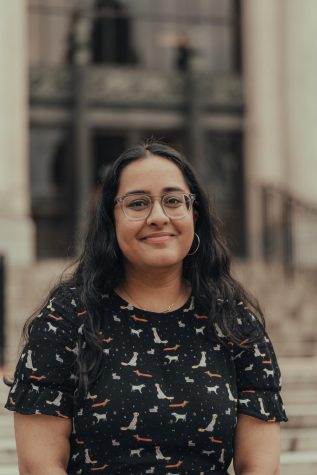OSP, OSU leadership urge OSU community members to follow COVID-19 policies, Code of Student Conduct
October 6, 2020
Editor’s Note: This article is a part of the 2020 OSU Back-to-School Issue. The Baro has put together this issue to inform Oregon State University’s incoming class, as well as returning students about the impacts COVID-19 has had on the university and what to expect this fall.
With COVID-19 reshaping the college experience, the enforcement of policing and public measures has not changed with the new health policies.
Lieutenant of the Oregon State Police Craig Flierl said via email that he does not foresee any significant departures to campus policing this fall term. As the law enforcement provider to the campus through Dec. 31, 2020, Flierl said via email that OSP continues to work collaboratively with other OSU community stakeholders such as the Department of Public Safety, Student Conduct and Community Standards and University Housing and Dining Services to effectively resolve community issues and concerns.
“To date, there have been no issues surrounding violations of OSU’s physical distancing policy being reported to OSP,” he said via email, “In the event they are, it is likely information would be obtained and forwarded to Student Conduct and Community Standards for administrative action.”
Carol Millie, director of the Office of Student Conduct and Community Standards, said via email that the office has received a variety of reports from the community regarding concerns related to the university’s COVID-19 face covering and physical distancing policies. Millie said they respond to all reports of alleged violations of the Code in which Oregon State University students are involved.
“Students, faculty, staff and community members are encouraged to report behavior that appears to conflict with the expectations of the Code of Student Conduct or disrupt our shared living, learning and working environments,” Millie said via email. “Our office is responsible for investigating, adjudicating and resolving alleged violations of the Code of Student Conduct.”
SCCS may receive reports of alleged violations of the Code of Student conduct from DPS, the Corvallis Police Department, and OSP regarding alleged violations of OSU’s COVID-19 Safety Policies, Millie said via email.
“The Code provides for a range of sanctions that include accountability, prevention and educational outcomes,” Millie explained via email. “Students interested in learning more about the range of sanctions that could be assigned if they violate the Code are encouraged to review Section 6 of the Code, which can be found here.”
Generally, Millie said via email, OSU students adhere to the behavior expectations of the Code and are respectful of the student accountability process. Students involved with violations of COVID-19 policies have been interested in learning more about the policies and developing personal behaviors that align with these policies.
Flierl urges students and OSU community members to be mindful and respectful of the social distancing policies of the university and the rules put in place by Oregon Gov. Kate Brown and the Oregon Health Authority. He also said via email that OSP will take a voluntary compliance and educational role in these matters as they relate to student gatherings.
“In terms of the campus population, [COVID-19] hit and rolled into the summer break, which is historically a slow period of time on campus due to a much smaller student body population. The university has done a phenomenal job of [informing] health, safety concerns and expectations for students, staff and faculty,” he said via email. “This was clearly visible over the past week as students checked in for the fall term. I have been impressed with the university’s open dialog and high level of communication with the OSU community group members.”
Policing on campus and responses to calls for service has not really been impacted in a negative way by COVID-19, Flierl said via email.
“We have taken more complaints over the phone to ensure social distancing can be maintained and at the same time provide an acceptable level of service to the community,” Flierl said via email. “Calls that would normally require a uniformed police officer to respond are still being responded to in this fashion with the officer(s), keeping in mind the use of personal protective equipment and social distancing.”
Michael Green, vice president for Finance and Administration and chief financial officer for Oregon State University, oversees Public Safety at OSU.
“The OSU Code of Student Conduct establishes the expectation that all students will adhere to all OSU policies, including policies regarding face coverings and physical distancing, and OSU’s policy that prohibits social get-togethers of more than ten people,” Green said via email. “We are engaging in a great deal of public health education on and off campus.”
Student behavior that does not meet OSU’s values and expectations of behavior may be viewed as a violation of the Code of Student Conduct and addressed through the established policies and procedures of the code, Green said via email.
In general terms, Flierl said via email, OSU rules are enforced by DPS officers and Student Conduct and Community Standards, while Oregon State Troopers enforce state laws.
“These can be classified as crimes or violations. Police officers have a lot of discretion in the enforcement of these laws. In terms of students, they should be mindful that while they may receive a warning for, say an MIP, they can still be sanctioned by OSU through the student conduct policy and procedures process,” Flierl said via email.
An MIP means a Minor in Possession—of, for example, alcohol or marijuana.
Additionally, Flierl recommended via email that everyone locks their vehicles and removes expensive belongings, help the police by reporting suspicious activity or people, travel in safe groups of people they trust whenever possible, avoid travelling alone at night and do not allow people they do not know to “piggyback” into residence halls or other secured-access buildings. Document serial numbers, said Flierl via email, and take photos of bicycles, computers and other sensitive property in the event they are stolen.
“The pandemic certainly has been challenging as we balance the needs for the health and safety of our student[s], faculty and staff while delivering the excellent education and research that is our university’s mission,” Green said via email. “During the pandemic, we have continued to maintain an appropriate public safety and law enforcement presence on campus and will continue to do so.”
Green stressed the importance that students and other members of the OSU community follow the university’s physical distancing and face-covering policies.
“We will continue to focus on the safety and success of our students, faculty and staff. We look forward to a successful fall term,” he said via email.
Steve Clark, vice president of University Relations and Marketing at OSU, said via email that work at OSU has been very focused on contributing to the safety and success of students, employees and community members.
“This effort continues to grow as the impacts of the pandemic expand or change,” Clark said via email.
“Public safety at the university remains OSU’s top priority even while there are fewer faculty, staff and students on campus in fall term due to the pandemic. The university’s commitment to providing for safety in an educational environment and in keeping with community values does not change due to the pandemic.”
Millie encourages all students, staff, faculty, and community members to become familiar with OSU’s COVID-19 Safety Policies and the student conduct process, and to continue to report concerning behavior or potential violations of the Code of Student Conduct.
The full Code of Student Conduct can be found here. To report concerns about student misconduct and COVID-19, a Public Report Form can be found here.




















































































![Newspaper clipping from February 25, 1970 in the Daily Barometer showing an article written by Bob Allen, past Barometer Editor. This article was written to spotlight both the student body’s lack of participation with student government at the time in conjunction with their class representatives response. [It’s important to note ASOSU was not structured identically to today’s standards, likely having a president on behalf of each class work together as one entity as opposed to one president representing all classes.]](https://dailybaro.orangemedianetwork.com/wp-content/uploads/2025/03/Screenshot-2025-03-12-1.00.42-PM-e1741811160853.png)
























